
Art Aquarium Museum Ginza: Guide to Tokyo's Vibrant Living Exhibition (+Tickets)
- Written by: Chehui Peh
Looking for a unique art experience in the middle of Tokyo? The Art Aquarium Museum Ginza will not disappoint. Designed to be a living art exhibition that changes with each season, there are over 5000 goldfish, across a hundred different varieties, swimming gracefully in exhibits throughout the museum. It’s a beautiful, wondrous space that aims to bring the best of Japanese aesthetics and culture to their visitors, while showcasing the goldfish in tanks that act as the canvas for these living art pieces.
About Art Aquarium Museum Ginza
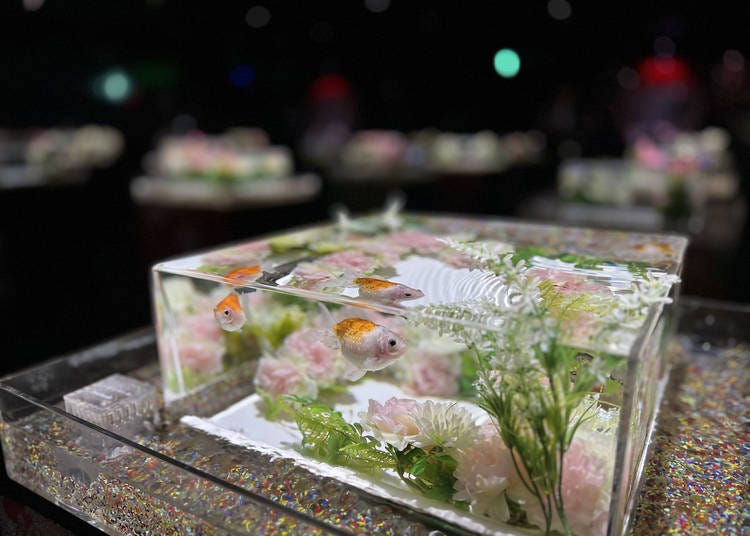
Opened in May 2022, the museum relocated from its last location in Nihonbashi. A sensory experience designed to delight your senses, visitors are invited to enjoy the museum through light, sound, as well as the dedicated scents in each area in order to give people a different feeling each time they enter a new space.
The appreciation of goldfish in Japan began in the Edo period (1603-1867). Goldfish were admired for their beauty, and this museum keeps this context in mind throughout, creating a space that can be photographed for its beauty at every angle, and in every space. With rare varieties of goldfish throughout the museum, the pure admiration of goldfish, whether in a group or alone, is another way to enjoy this museum that almost seems to bring you to an Underwater Wonderland.
- Buy tickets online in advance for a seamless entry into the museum. You’ll also be able to choose the designated timing you desire.
- If you’re there for an Instagrammable or TikTok-worthy experience, it’s worth it to think about getting that yukata rental beforehand. The space is perfect for a mini photoshoot, and photography and video are permitted throughout the museum. Note that flash photography or tripods are not allowed.
Entering the museum: From Ginza to Underwater
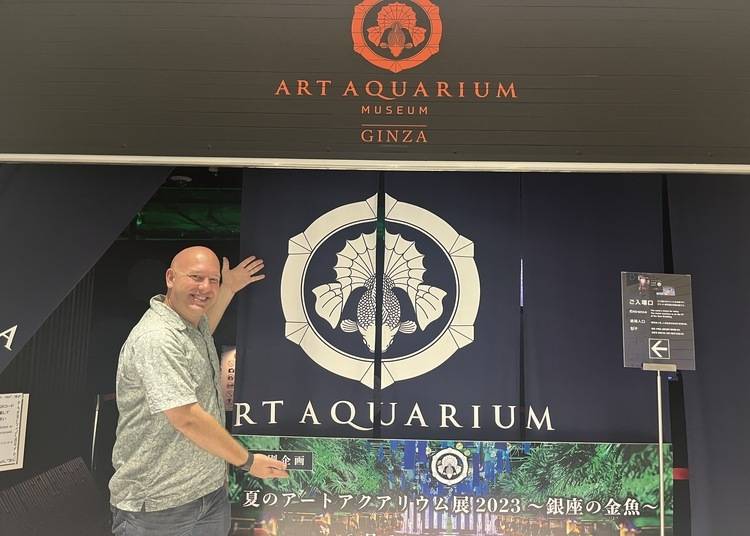
You enter the museum by going from the bright lights of the department store into the dark, stepping onto a bridge framed by hanging lanterns, reminiscent of the lanterns at Nara’s Kasuga Taisha Shrine. Titled the Ginza Mantoro, the bridge is the start of leaving Ginza into the underwater world, and almost brings to mind the bridges leading into a shrine.

The bridge leads further into a goldfish corridor, with inspiration taken from columns and corridors commonly seen in temple and shrine architecture. The columns give a feeling of infinite space, showcasing the beautiful goldfish dancing in their multicolored tanks, almost as if they are in unison to the music.
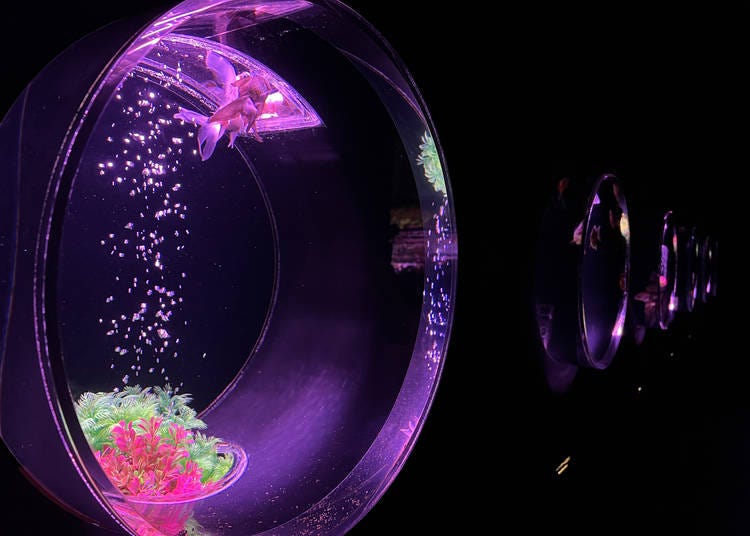
The goldfish collection at the end of the corridor almost brings to mind rounded windows in an underwater submarine. With rare goldfish varieties exhibited like in an art gallery, this is the perfect section for marine lovers. With the lighting effect and the glass of the tank, the goldfish can be admired from various points and appear almost ethereal from certain angles.
If you’re a bonsai lover, the goldfish display cabinet is sure to delight. The combination of traditional bonsai by bonsai master Masashi Hirao, as well as Kosyo Nemoto’s Edo Kiriko works, a traditional Japanese glass craft framing the colorful fishes, is a sight to behold.

With the summer heat outside, the Goldfish Waterfall next with its multi-layered walls of water calmly flowing in a downward motion amidst a faint light gives visitors a cooling sensation.
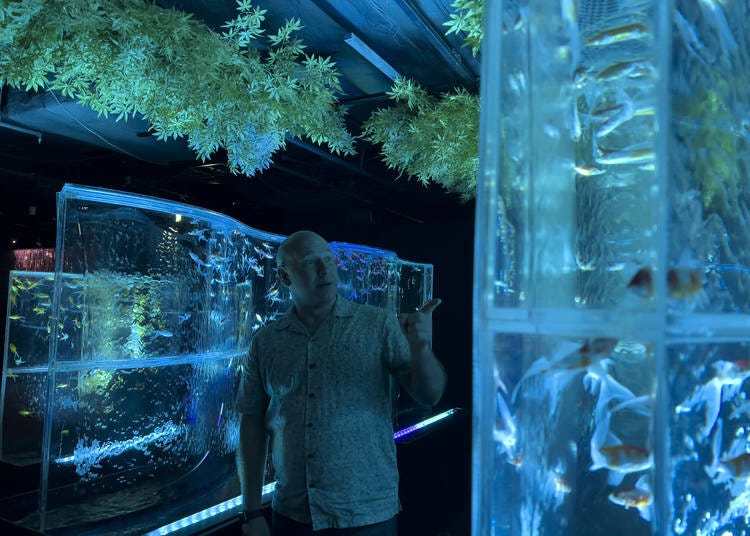
Goldfish give off a summery vibe in the Japanese imagination, hence the space between the waterfall tanks for you to bathe in this unique waterfall space, while listening to the sound of water splashing and the scent of nature, and getting up close to admire the swimming goldfish. Framing the Goldfish Waterfall on either side are Goldfish Stone Lanterns, which seem to flicker with the light of the fish swimming within.
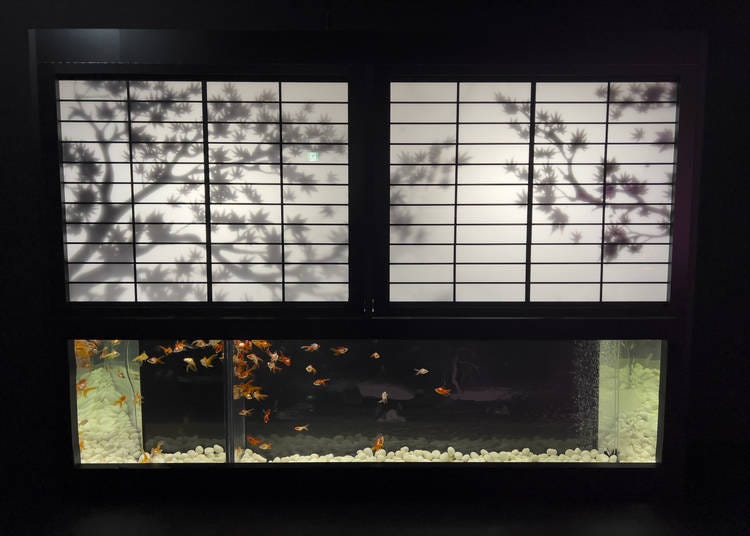
From the blue waters to Japanese gardens, the Shojirium frames the scenes of the changing seasons of a Japanese garden, subtly visible beyond the world of the goldfish. This was inspired by the lower atrium shoji screens in the Bosenseki tea room at Daitoku-ji Temple in Kyoto.
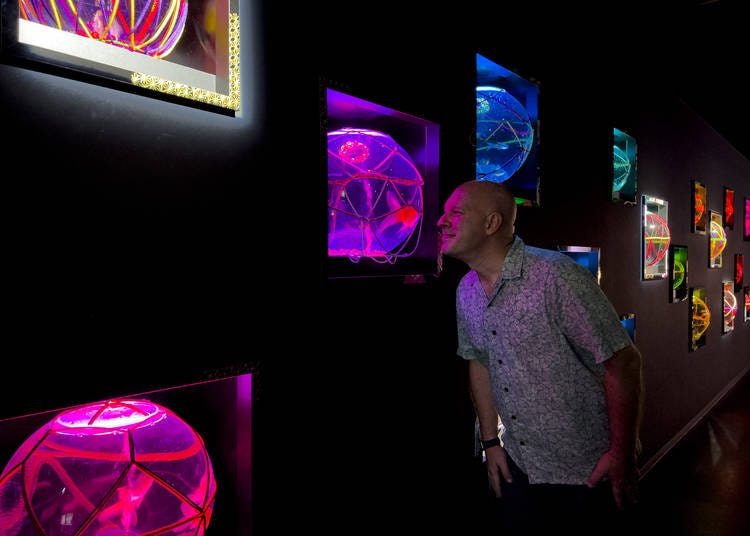
From the tranquil scene of Japanese gardens to the playful Temaririum, the temari are a traditional play item that went on to become art objects, and the woven patterns across the tanks with the graceful goldfish swimming between the designs add on to the cheerfulness of this scene.
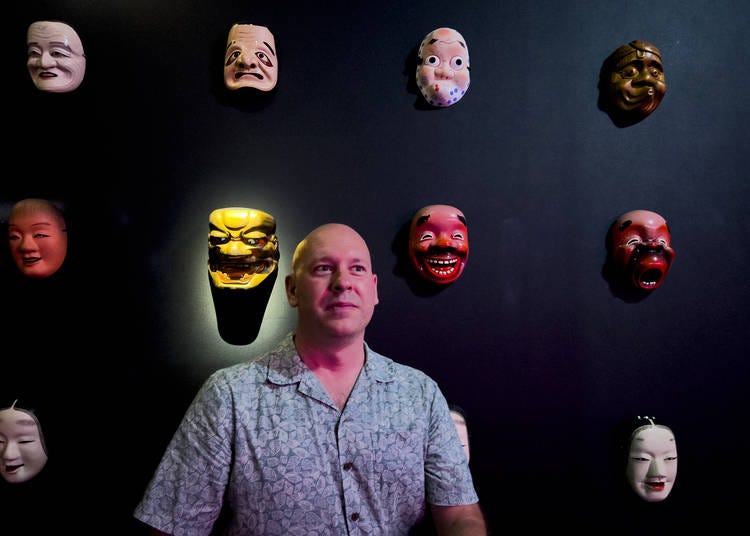
Behind that is a wall with Japanese face masks that look so real, the camera identifies them as human faces. Which camp are you in, a little scary, or beautifully traditional crafts? These masks have appeared throughout history since the age of the gods and are used for various purposes other than decoration, including rituals. These masks have a history to them, and are independently collected by the museum.
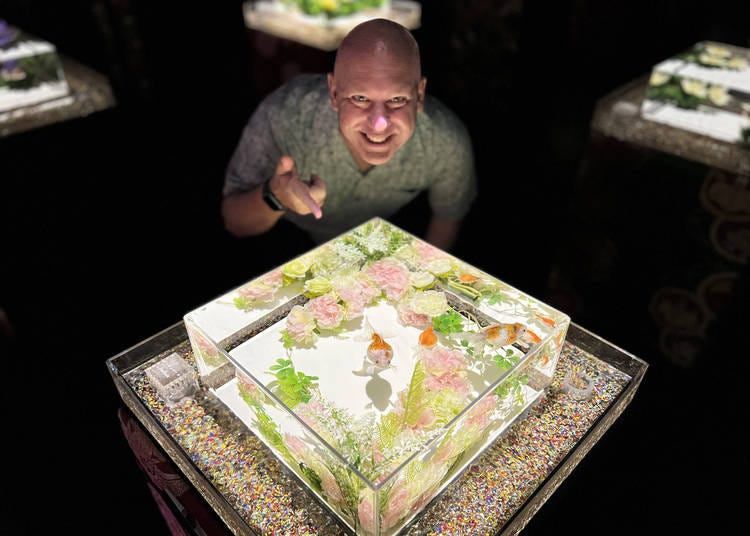
We then move into the Show of Kingyo - literally translated into the showing of the goldfish. These low square tanks exhibit different varieties of goldfish with specially made craft flowers that change seasonally, allowing visitors to appreciate the goldfish from above, bringing to mind the ancient way of admiring a goldfish in tanks from a higher angle. The shadows of the goldfish blend in with the flowers beautifully, creating art that is constantly changing.
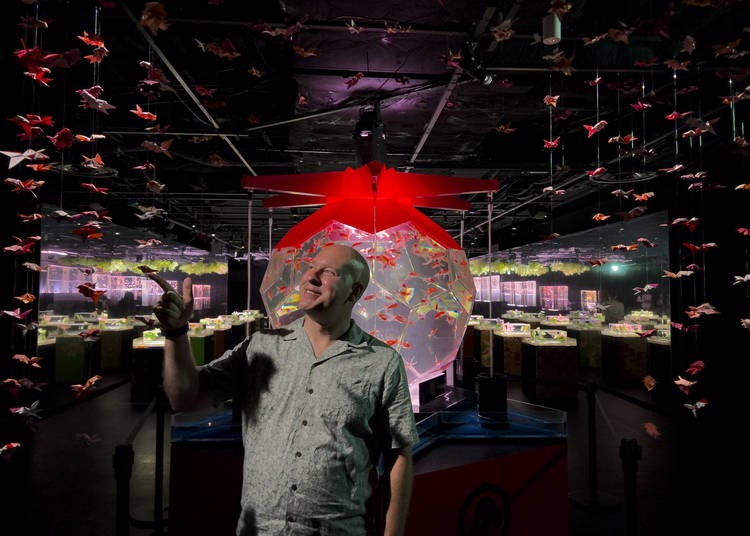
For the best photo spot in the museum, head over to the Origamirium, where an exceptionally large goldfish bowl inspired by origami is on display, decorated with origami goldfish.

The Teitourium next, which give the image of a summer festival or matsuri, are lined with lantern-shaped tanks with magnifying lens, making the goldfish appear larger and more fantastical than they are, and making us comically smaller for the goldfish.

The lanterns also bring us back to the start of the museum where we approach the shrine after the festival. With summer, the wind chimes above hanging from green leaves slowly chime to the indoor breeze, adding another dimension to the sound, before leading us to the gorgeous Bamboo Grove Seven Sages, before bringing us to a separate space with an Inome, a heart-like pattern used since ancient times in Japan to ward off evil and bring good luck.
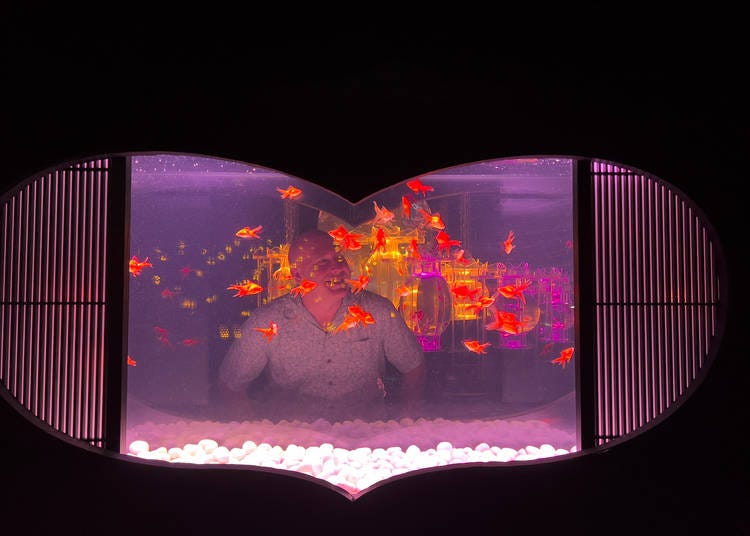
A pattern that is frequently spotted in shrines and temples, the goldfish elegantly swim in the window. For a fun photo opportunity, do go behind the windows to see what the world looks like from both sides!
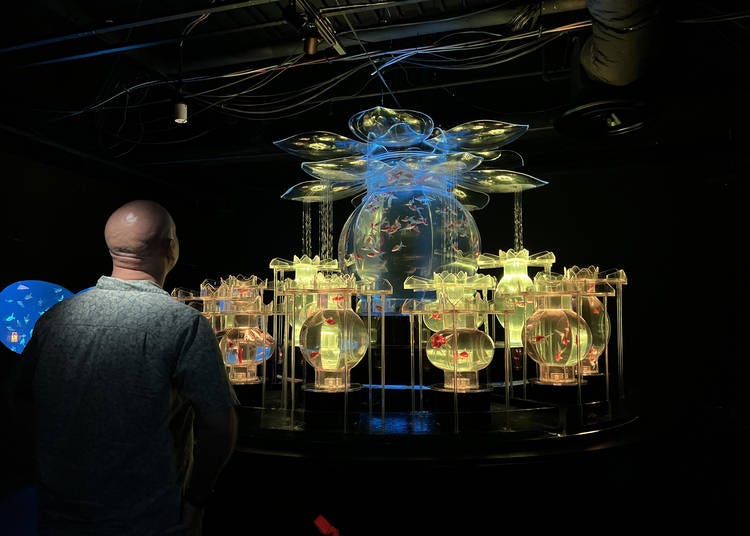
Turn around to the Tenkurium, a tank inspired by imaginary flowers blooming in the sky, a depiction of a fantasy world of flowering aquariums.
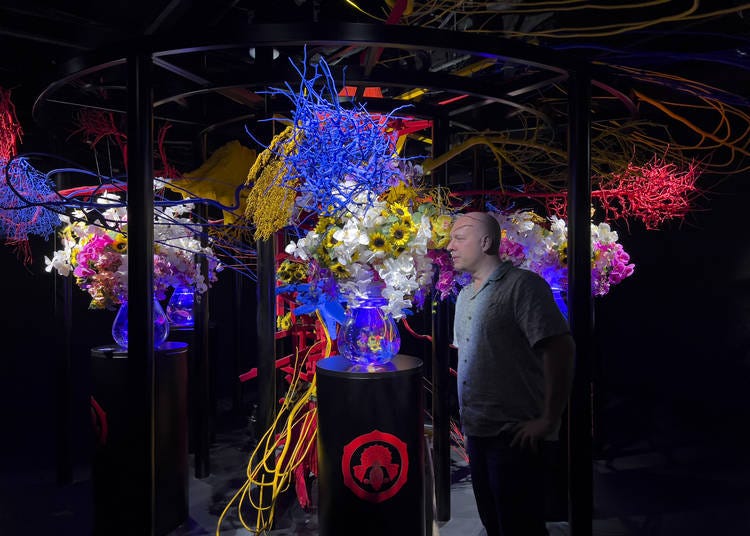
Continuing the flower motif is a collaboration with flower arrangement artist Shogo Kariyazaki, with a colorful burst of ikebana (flower arrangement) and goldfish. This is a space you can admire 360 degrees, with dynamic and vibrant colors adding to the beauty of this Flowerium, and ending our journey through the world of goldfish art.
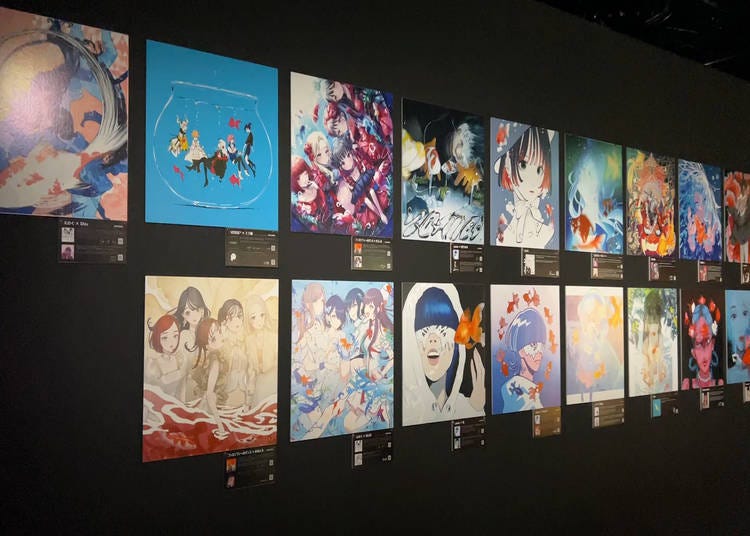
Other than the lively exhibitions of ever-swimming goldfish, there are also ever-changing exhibitions of works created by artists using Art Aquarium as a motif. In addition, visitors can enjoy a collection of ukiyo-e works created by Edo-era artist Utagawa Kuniyoshi featuring goldfish and carp, with the depictions meant to create a different 2D art world.
Souvenirs, anyone?

Round off your visit with a trip to the gift shop. The shop mostly sells seasonal items, but their Top 3 souvenirs are year-round. These are the tenugui (Japanese hand towels) which are 1,430 yen each, the acrylic initial keychains that imitate a goldfish tank at 1,200 yen each, and the goldfish motif earrings that start from 1,980 yen for a pair. All prices also include tax.

For those summer vibes, grab yourself a wind chime or fans (from 550 yen); or opt for the adorable and surprisingly soft goldfish plushies that start from 1,540 yen going up to 9,900 yen for a large one. If you find yourself a fan of the scents used throughout the museum, grab yourself a mini bottle at 2,420 yen, or the original CD compilation of the artist-produced songs throughout the exhibit. Payment can be made either via credit card, or cash.
Changing with the seasons
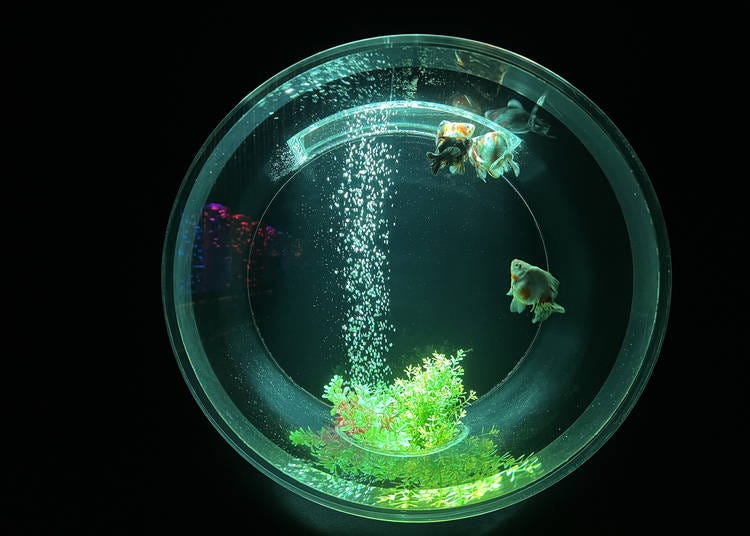
Although this visit was in the summer, the exhibit changes seasonally, and the next change is due in mid-September when autumnal-themed exhibits will be featured. Each season brings about changes to the exhibitions, and you’ll be able to enjoy the four seasons of Japan depending on when your visit is. Spring, with its sakura-centered exhibits, is also a particularly popular season for the museum.
How to get to the Art Aquarium Museum Ginza

Entry to Art Aquarium Museum is on the 9th Floor of the Mitsukoshi Shinkan, where visitors will have to go down the escalators to the 8th Floor, where the entrance is located.
Art Aquarium Museum tickets
Art Aquarium Museum tickets can be bought online in advance on their website, or at the ticket machines located at on the 9th floor of Ginza Mitsukoshi Shinkan.
-

-
Address
Ginza Mitsukoshi New Building 9th floor entrance, 4-6-16 Ginza, Chuo-ku, Tokyo, 104-8212
View Map -
Nearest Station
Ginza Station (Tokyo Metro Ginza Line / Tokyo Metro Marunouchi Line / Tokyo Metro Hibiya Line)
3 minutes on foot
- Phone Number 03-3528-6721
-
Address
Ginza Mitsukoshi New Building 9th floor entrance, 4-6-16 Ginza, Chuo-ku, Tokyo, 104-8212
(This article was published in September 2023. For the latest information, see the official Art Aquarium Museum website.)
With over 10 years of experience as a writer and marketer, Chehui writes extensively about travel, lifestyle, and food. Traveling is a part of her lifestyle, and she travels every chance she gets with the goal to explore all corners of Japan, no matter how difficult it is to get to. Graduated with a Masters of Anthropology from Waseda University and worked as a freelance journalist at Shanghai Daily for over 4 years, before branching out to travel journalism and contributing to Travel + Leisure and other renowned platforms. She holds certifications in Japanese Tea Ceremony, and Wine.
- Area
- Category
*Prices and options mentioned are subject to change.
*Unless stated otherwise, all prices include tax.
Popular Tours & Activitiess
Recommended places for you
-

A Travel Game Changer! Go Hands-Free Between Tokyo and Kyoto with LUGGAGE EXPRESS by JTB and JR Tokai
by: Guest Contributor
-

New Seibu L00 Series Launching in 2026! What to See Along the Tokyo-Area Golden Route
by: Guest Contributor
-

Enjoy Japan's Gorgeous Winter Lights! Ride the Romancecar to Shonan no Hoseki Illumination
by: Guest Contributor
-

The Best Japanese Food Representing 2025! 'Dish of the Year®' Annual Award Results Announced
-

Get Ready to Catch 'Em All! First Ever Permanent Outdoor Pokémon Park Opening Near Tokyo!
-

Keisei × Keikyu 16-Temple Goshuin Tour: Discover Deeper Tokyo & Yokohama
by: Guest Contributor
Inspiration for Accommodations
-

Enjoy Mt. Fuji from the Comfort of Your Room! Recommended Ryokan with Mt. Fuji View
-

Stay Near the Cherry Blossoms! Hotels for Cherry Blossom Viewing in Tokyo
-

Family-Friendly Hotels with Free Shuttle to Disneyland: Convenient Access for a Magical Stay
-

Top Ranked Hakone Hotels with Mt. Fuji View: Enjoy Stunning Scenery from Your Private Space
-

Convenient Tokyo Hotels with Airport Shuttle: Ideal for Families and Heavy Luggage
-

Stunning Tokyo Tower View Hotels: Enjoy Spectacular Scenery from Your Private Space
-

Convenient Asakusa Hotels with Kitchens: Ideal for Extended Family Visits
-

Experience Luxury: Hakone's 10 Best Five-Star Accommodations
-

Enjoy Mt. Fuji Autumn Leaves! Top Hotels Near the Popular Autumn Leaves Corridor
-

Experience Hakone Fall Foliage from Your Room with Stunning Views
-

Checking Out Tokyo's Samurai Museum: Get to Know the Spirit of Japan’s Ancient Warriors
by: Holly Neslusan
-

Five Museums Where You Can Enjoy Japanese Culture for Free
-

Essential Tokyo: The Complete Guide to Ikebukuro Station
-

Shibuya Crossing: Getting the Best View from the Deck at Magnet by Shibuya109!
-

Become a Samurai at the Samurai Museum in Tokyo!
-

Complete Guide to Buying Japanese Medicine in Japan: Phrases and Vocabulary You Need to Know
- #best ramen tokyo
- #what to buy in ameyoko
- #what to bring to japan
- #new years in tokyo
- #best izakaya shinjuku
- #things to do tokyo
- #japanese nail trends
- #what to do in odaiba
- #onsen tattoo friendly tokyo
- #daiso
- #best sushi ginza
- #japanese convenience store snacks
- #best yakiniku shibuya
- #japanese fashion culture
- #best japanese soft drinks





















